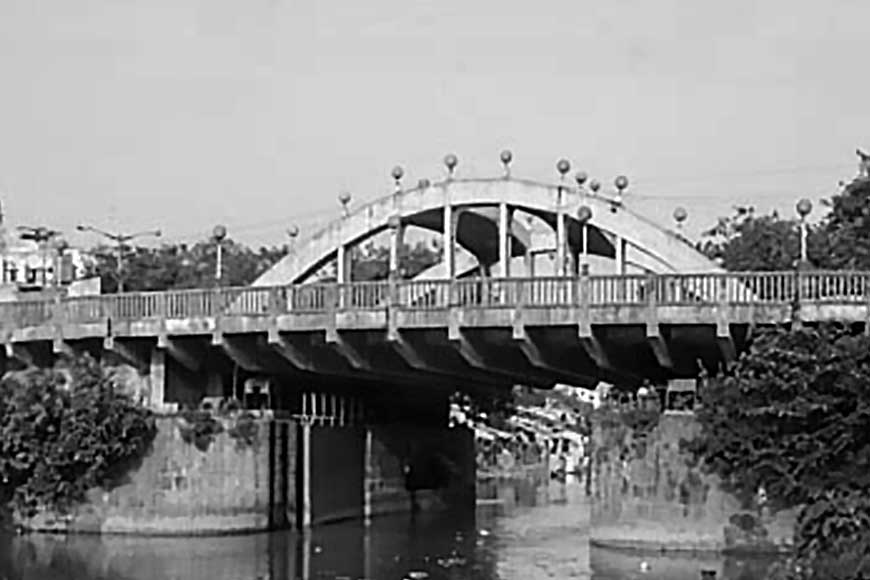Chitpur Bridge — The Bridge that protected Kolkata from Maratha Bargis

Calcutta had seen a huge influx of British entrepreneurs, like trade agents engaged in commercial transactions, traders, shopkeepers, and labourers looking for earning opportunities in the middle of the city’s expansion. From only eight brick-built (described as ‘pucca’ in contemporary records) houses in 1706, the number rose to 498 in 1756 along what we call Chitpur today. They were mainly inhabited by English traders and administrators, who were later joined by Bengali and other Indian entrepreneurs.
British settlers and administrators started the process of urbanization of the small rural settlements of Bengal by clearing jungles. Maps and accounts available from the turn of the 18th century show that at the time of the British arrival, Calcutta had only two arterial roads and no bridges to cross the numerous canals and rivulets. One such road ran from the North in Chitpur to the south in Kalighat through the jungles of the neighbouring villages of Chourungi (later turned to Chowringhee). This road was known as the ‘Pilgrim Road’ by contemporary British settlers, because of the Hindu devotees who used it to reach the Kali Temple in the south. The other was a parallel road on the east (later known as the Circular Road), which moved down towards the south-west.
With the building of Fort William in the western zone of Gobindapur village, on the banks of the Hooghly, large-scale displacement of villagers took place. The East India Company gave cash compensation to the Bengali well-to-do families who owned brick-built houses and encouraged them to move northwards and buy lands and settle in the Sutanuti area. This led to the development of settlements on either side of the old Chitpur Road, that came to be known as Black Town in the parlance of the British colonial authorities as well as European travellers.
Calcutta had only two arterial roads and no bridges to cross the numerous canals and rivulets. One such road ran from the North in Chitpur to the south in Kalighat through the jungles of the neighbouring villages of Chourungi (later turned to Chowringhee). This road was known as the ‘Pilgrim Road’ by contemporary British settlers, because of the Hindu devotees who used it to reach the Kali Temple in the south.
Interestingly, before establishment of East India Company’s rule, the Sheths or the trader community of Bengal had started clearing jungles of Sutanuti (which was to be a part of the future city of Calcutta) and constructed a lane from the west to the east (today’s Bagbazar Street) to facilitate transport of their goods to the harbour on the River Hooghly. They built houses for themselves and set up markets where European traders came to buy their merchandize. After the East India Company took over this site in 1698, it chose the Sheths as their protégés for their plan of future urbanization. In 1707, the Company reduced ground rents for the estates of the Sheths in Sutanuti. In exchange for the concession, they issued a notification stating:
Also read : It is the British soil that formed Strand Road
In consideration that Janundun Seat [Jadunandan or Janardhan Sheth], Gopaul Seat, Jadoo Seat, Banarsi Seat [all Sheths] and Jay Kissen will keep in repair the highway between the Fort’s landmark to the norward on the backside of the town, we have thought fit to abate them 8 annas a bigha of their garden rent, which is about rupees 55 in the whole less than it is ordered.
Thus, Bengali merchants were entrusted with maintenance of the arterial road known as Chitpur Road that ran from the north to the south near the site of the then Fort William (today’s General Post Office in Dalhousie Square). As the opulence of this trading community grew, fear of being attacked by the Maratha thugs popularly known as Bargis largely grew into a nightmare. The ruthless Bargis had earlier carried out looting in the prosperous countryside of Bengal specially during the reign of Alivardi Khan. The Sheths were afraid that they would now come to loot the nouvue rich trading community who settled around Chitpur.
Hence in 1742, a 3-mile long moat was dug to protect Calcutta from the marauding Bargis. This turned into a major canal at Chitpur that was revitalized in 1824, when the municipal authorities decided to use the waterways for transport. For communication a bridge needed to be built and thus in 1843 came up Chitpur Bridge under the engineering leadership of Captain John Thomson, who was the Superintendent of Canals and Agent for Iron Suspension Bridges. Valued at Rs. 39,344, spanning 99 feet, the roadway on it was 22 feet wide. It was popularly referred to as the Baghbazar Bridge.
W.H. Carey in The Good Old Days of Honorable John Company (1882) records that under the bridge was a lock for allowing boats to pass between the river Hooghly and the Circular Canal at all times of the tide. ‘This lock is 60 feet long and nearly 24 feet wide, with double gates.’ And herein came the engineering prowess of James Prinsep, who built this lock at an expense of 61,000 sicca rupees. Later, a new bridge was built a little to the East of the original bridge in 1934, this came to be known as the Chitpur Bridge.










